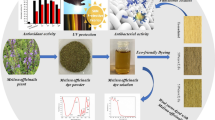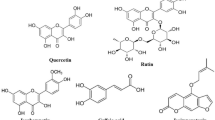Abstract
This work presents the valorization of Millettia laurentii carpentry sawdust waste into sustainable natural dye for ecological dyeing and functional finishing of wool textiles. A simple aqueous extraction method was used to isolate natural dye, then the extracted bio-dye was subjected to different qualitative and quantitative analyses. Wool yarns were dyed in conjunction with different metal salts (aluminum sulfate, ferrous sulfate, copper sulfate, and zinc sulfate) and their binary combinations (Al/Fe, Al/Cu, Al/Zn, Fe/Cu, Fe/Zn, and Cu/Zn) as mordants. Practically, 11 different eco-friendly shades were developed of varying hues and tones employing 75% (o.w.f.) of M. laurentii sawdust. The antibacterial action against E. coli and S. aureus, free radical scavenging power, and UV protection properties of dyed wool yarns were recorded. The introduction of different metal salts and their combinations enhanced the color properties with a semi-durable antimicrobial and antioxidant finish. Statistical analysis of the color parameters of binary mixed metal combinations confirms the synergetic contribution of individual metal ions in each combination. The amount of individual mordant adsorbed (weight percentage) from a particular combination was further assessed by EDX analysis of mordanted dyed wool yarns. Overall, the results suggest that copper sulfate and ferrous sulfate pre-treatment were the best combinations (Fe/Cu) for wool yarns in conjunction with 75.0% (o.w.f.) M. laurentii sawdust, considering the color fastness, antimicrobial, and antioxidant properties. The results provide ample scope for the upcycling of timber industry waste into a natural dye for the eco-friendly coloration of wool textiles.
Graphical Abstract









Similar content being viewed by others
Data availability
Data will be available by the corresponding authors upon reasonable request.
References
Bechtold T, Mussak R (2009) Handbook of Natural Colorants. John Wiley & Sons, Chichester, UK
Safapour S, Rather LJ, Mazhar M (2023) Coloration and functional finishing of wool via Prangos ferulacea plant colorants and bioactive agents: colorimetric, fastness, antibacterial, and antioxidant studies. Fibers Polymers 24(4):379–1388
Rather LJ et al (2020) Valorization of natural dyes extracted from Mugwort leaves (Folium artemisiae argyi) for wool fabric dyeing: optimization of extraction and dyeing processes with simultaneous coloration and biofunctionalization. ACS Sustain Chem Eng 8(7):2822–2834
Jahan R, Arju S, Nahar K (2023) A new approach to eco-friendly dyeing of cotton fabric with vat dyes using plant extract as natural reducing agents. Progress Color Colorants Coat 16(1):83–96
Imani H, Gharanjig K, Ahmadi Z (2022) A novel efficient method for eco-friendly deep dyeing of wool yarns by extracted madder dyes in the presence of additives. Ind Crops Prod 183:114970
Hosseinnezhad M et al (2023) Environmentally dyeing of wool yarns using of combination of myrobalan and walnut husk as bio-mordants. Progress Color Colorants Coat 16(2):197–205
Prabhu K, Teli M (2014) Eco-dyeing using Tamarindus indica L. seed coat tannin as a natural mordant for textiles with antibacterial activity. J Saudi Chem Soc 18(6):864–872
Haji A, Mousavi Shoushtari A, Mirafshar M (2014) Natural dyeing and antibacterial activity of atmospheric-plasma-treated nylon 6 fabric. Color Technol 130(1):37–42
Rather LJ et al (2021) Binary mix metal mordant dyeing of merino wool fibers using Cinnamomum camphora waste/fallen leaves extract: a brief statistical analysis of color parameters. J Textile Inst 112(5):742–751
Chikri R, Elhadiri N, Benchanaa M (2020) Efficiency of sawdust as low-cost adsorbent for dyes removal. J Chem 2020:8813420.
Sahmoune MN, Yeddou AR (2016) Potential of sawdust materials for the removal of dyes and heavy metals: examination of isotherms and kinetics. Desalin Water Treat 57(50):24019–24034
Kandasamy N, Kaliappan K, Palanisamy T (2021) Upcycling sawdust into colorant: ecofriendly natural dyeing of fabrics with ultrasound assisted dye extract of Pterocarpus indicus Willd. Ind Crops Prod 171:113969
Chen K et al (2018) Identification of compounds with cytotoxic activity from Millettia dorwardi Coll. Et. Hemsl. Phytochem Lett 25:60–64
Sritularak B, Likhitwitayawuid K (2006) Flavonoids from the pods of Millettia erythrocalyx. Phytochemistry 67(8):812–817
Marco M et al (2017) Pterocarpans and isoflavones from the root bark of Millettia micans and of Millettia dura. Phytochem Lett 21:216–220
Madhu D et al (2016) An economically viable synthesis of biodiesel from a crude Millettia pinnata oil of Jharkhand, India as feedstock and crab shell derived catalyst. Biores Technol 214:210–217
Jena R et al (2020) A review on genus Millettia: traditional uses, phytochemicals and pharmacological activities. Saudi Pharm J 28(12):1686–1703
Kamnaing P et al (1994) Millettonine, a guanidine alkaloid from Millettia laurentii. Phytochemistry 36(6):1561–1562
Banzouzi J et al (2008) Traditional uses of the African Millettia species (Fabaceae). Int J Bot 4(4):406–420
Kamnaing P et al (1999) An isoflavan-quinone and a flavonol from Millettia laurentii. Phytochemistry 51(6):829–832
https://publications.gc.ca/site/eng/9.819974/publication.html. Accessed 2023-03-24.
Sultana B, Anwar F, Przybylski R (2007) Antioxidant activity of phenolic components present in barks of Azadirachta indica, Terminalia arjuna, Acacia nilotica, and Eugenia jambolana Lam. trees. Food Chem 104(3):1106–1114
Safapour S, Rather LJ (2022) Effect of single and binary mixed metal mordant combinations on colorimetric and fastness characteristics of wool yarns dyed with Melissa officinalis L. natural colorants. J Textile Inst 1–9. (In press)
Ricci A et al (2015) Application of Fourier transform infrared (FTIR) spectroscopy in the characterization of tannins. Appl Spectrosc Rev 50(5):407–442
Ping L et al (2012) Wood adhesives from agricultural by-products: Lignins and tannins for the elaboration of particleboards. Cellulose Chem Technol 46(7–8):457–462
Chen YM et al (2010) Polymerization of catechin catalyzed by Mn-, Fe-and Al-oxides. Colloids Surf B 81(1):217–223
Huang X et al (2010) One-step, size-controlled synthesis of gold nanoparticles at room temperature using plant tannin. Green Chem 12(3):395–399
Ozgunay H, Sari O, Tozan M (2007) Molecular investigation of valonea tannin. J Am Leather Chem Assoc 102(05):154–157
Pardeshi S, Dhodapkar R, Kumar A (2013) Quantum chemical density functional theory studies on the molecular structure and vibrational spectra of gallic acid imprinted polymers. Spectrochim Acta A Mol Biomol Spectrosc 116:562–573
Arana J et al (2001) Highly concentrated phenolic wastewater treatment by the photo-Fenton reaction, mechanism study by FTIR-ATR. Chemosphere 44(5):1017–1023
Ajuong E, Breese MC (1998) Fourier transform infrared characterization of Pai wood (Afzelia africana Smith) extractives. Holz als Roh-und Werkstoff 56(2):139–142
Murugananthan M, Bhaskar Raju G, Prabhakar S (2005) Removal of tannins and polyhydroxy phenols by electro-chemical techniques. J Chem Technol Biotechnol 80(10):1188–1197
Pertuit D et al (2022) Oleanane-type glycosides isolated from the trunk barks of the Central African tree Millettia laurentii. Fitoterapia 159:105193
Czajkowski W, Szymczyk M (1998) Iron complexed afterchrome dyes. Dyes Pigm 37(3):197–204
Bardole HA, Freeman HS, Reife A (1998) Iron salts in the post-metallization of mordant dyes. Text Res J 68(2):141–149
Shin Y, Son K, Yoo D (2010) Development of natural dyed textiles with thermo-regulating properties. Thermochim Acta 511(1–2):1–7
Mouafo HT et al (2021) In vitro antimicrobial activity of Millettia laurentii De Wild and Lophira alata Banks ex CF Gaertn on selected foodborne pathogens associated to gastroenteritis. Heliyon 7(4):e06830
Ni C et al (2018) Molecules and functions of Rosewood: Millettia laurentii. Carib J Sci 51(3):527–535
Tazon WA et al (2022) In vitro and in vivo evaluation of the anti-diabetic, anti-hyperlipidemic and antioxidant properties of aqueous extract of Millettia laurentii bark (Fabaceae). J Med Herbs 13(1):37–48
Anjaneyulu Y, Rao RP (1986) Preparation, characterization and antimicrobial activity studies on some ternary complexes of Cu (II) with acetylacetone and various salicylic acids. Synth React Inorg Met-Org Chem 16(2):257–272
Giokas DL, Salvador A, Chisvert A (2007) UV filters: from sunscreens to human body and the environment. TrAC Trends Anal Chem 26(5):360–374
Sankaran A et al (2021) "Synthetic and natural UV protective agents for textile finishing" Innovative and emerging technologies for textile dyeing and finishing. pp 301–324
Acknowledgements
Tabriz Islamic Art University is gratefully acknowledged for all the supports throughout this research study.
Author information
Authors and Affiliations
Contributions
Siyamak Safapour: project administration, investigation, conceptualization, resources, experimental design and methodology, characterization, data curation, formal analysis, validation, visualization, and writing—review and editing of the original draft
Luqman Jameel Rather: investigation, conceptualization, data curation, formal analysis, validation, visualization, and writing—review and editing of the original draft.
Shazia Shaheen Mir: writing antibacterial and antioxidant activity of the original draft.
Qaiser Farooq Dar: statistical analysis of color parameters and writing corresponding part of the original draft.
Corresponding authors
Ethics declarations
Ethical approval
Not applicable
Competing interests
The authors declare no competing interests.
Additional information
Publisher's note
Springer Nature remains neutral with regard to jurisdictional claims in published maps and institutional affiliations.
Highlights
• An effective, facile, and eco-friendly process is presented for upcycling Millettia laurentii carpentry sawdust.
• Sustainable bio colorants were extracted and used for ecological dyeing and bio-functional finishing of wool.
• Different single and binary mixed metal mordants were used to improve color fastness and develop sober and new color shades.
• Bio-dyed wool samples demonstrated improved antibacterial and antioxidant activity which was durable to a great extent after 20 consecutive washing cycles.
• Bio-processed wool showed very good to excellent UV protection ratings.
Supplementary Information
Below is the link to the electronic supplementary material.
Rights and permissions
Springer Nature or its licensor (e.g. a society or other partner) holds exclusive rights to this article under a publishing agreement with the author(s) or other rightsholder(s); author self-archiving of the accepted manuscript version of this article is solely governed by the terms of such publishing agreement and applicable law.
About this article
Cite this article
Safapour, S., Rather, L.J., Mir, S.S. et al. Upscaling Millettia laurentii carpentry sawdust into natural dyes: imparting antimicrobial, antioxidant, and UV-protective finish to wool yarns through an ecological and sustainable natural dyeing process. Biomass Conv. Bioref. (2023). https://doi.org/10.1007/s13399-023-04184-y
Received:
Revised:
Accepted:
Published:
DOI: https://doi.org/10.1007/s13399-023-04184-y




